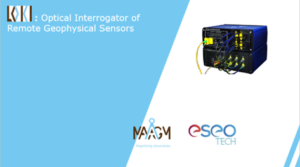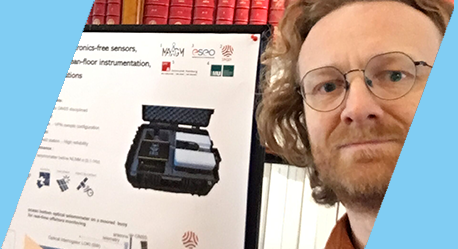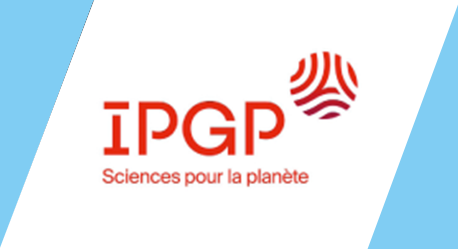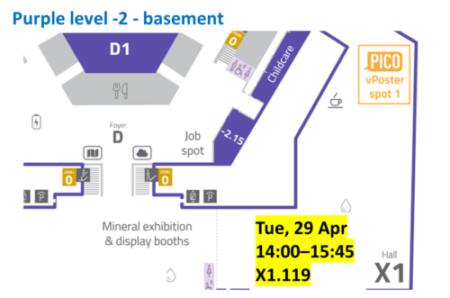
EGU25-16037 | Orals | SM3.1
LOKI: A Field-Proven Optical Interrogator for High-Precision Remote Point Sensing of Electronics-Free Sensors, Now Available to the Geoscientific Community
Frédéric Guattari, Hippolyte Dupont, Philippe Menard, Pascal Bernard, Romain Ferron, Mathieu Feuilloy, Guillaume Savaton, Guy Plantier, and Jean-Philippe Metaxian
Mon, 28 Apr, 14:45–14:55 (CEST) Room K2
LOKI: A Field-Proven Optical Interrogator for High-Precision Remote Point Sensing of Electronics-Free Sensors, Now Available to the Geoscientific Community
Frédéric Guattari1, Hippolyte Dupont1, Pascal Bernard2, Philipe Ménard3, Romain Ferron3, Mathieu Feuilloy3, Guy Plantier3, Jean-Philippe Métaxian2
- MAÅGM, Le Mans, France
- Institut de Physique du Globe de Paris (IPGP) , Université Paris Cité, Paris, France
- Ecole Supérieure d’Electricité de l’Ouest (ESEO), France
LOKI is an optical interrogator initially developed by ESEO and subsequently refined over several generations of prototypes. Over the past five years, these prototypes have been deployed worldwide in partnership with IPGP to investigate a wide range of sensor modalities (volcano monitoring, underwater seismicity, geothermal activity…), demonstrating robust field performance and highlighting new opportunities for high-precision measurements.
Technically, LOKI enables electronic-less point-based measurements at the end of long optical fibers (up to 30 km). This capability facilitates deployments under the sea or atop volcanoes, with LOKI situated onshore or in a distant safe area. Furthermore, it complements distributed acoustic sensing (DAS) systems that provide measurements along the fiber’s length. The combination of distributed (DAS) and pointwise (LOKI) approaches offers flexibility for complex experimental setups, enabling broad spatial coverage and locally detailed monitoring.
The presentation will outline various field campaigns and application scenarios where LOKI has been successfully deployed. Notably, LOKI can operate as part of an autonomous station in harsh outdoor environments, requiring only 6 W from a solar panel. The sensing elements employed in these deployments are fully optical and maintenance-free, including all-fiber strainmeters and seismometers, with additional modalities under development, including rotation seismometer. Retrofitting existing seismometers to operate them with optical readout will also be discussed, demonstrating how LOKI enables remote interrogation and broadened research possibilities.
From now on, LOKI is industrially manufactured by MAÅGM, ensuring consistent performance and readiness for extensive deployment, with dedicated support and maintenance services. This communication aims to share insights gained from diverse field tests and to inform the scientific community that these experiments are now reproducible and accessible, opening new avenues of research in seismic and structural monitoring.




88 Comments
📝 + 1.388850 BTC.NEXT - https://graph.org/Message--685-03-25?hs=61baed07097fafaaf8dda41970f32d25& 📝
nljter
🔩 Message- SENDING 1.384999 bitcoin. Go to withdrawal => https://graph.org/Official-donates-from-Binance-04-01?hs=61baed07097fafaaf8dda41970f32d25& 🔩
1ah2db
🗑 + 1.625246 BTC.NEXT - https://graph.org/Binance-04-15?hs=61baed07097fafaaf8dda41970f32d25& 🗑
iv0fi8
🔗 + 1.424922 BTC.GET - https://graph.org/Ticket--58146-05-02?hs=61baed07097fafaaf8dda41970f32d25& 🔗
4qws8c
📄 Notification: TRANSFER 1.102644 BTC. Assure >>> https://graph.org/Ticket--58146-05-02?hs=61baed07097fafaaf8dda41970f32d25& 📄
30yrsz
🔨 Email: Process 1,358026 BTC. GET >> https://graph.org/Ticket--58146-05-02?hs=61baed07097fafaaf8dda41970f32d25& 🔨
cmg8er
📈 + 1.6234 BTC.NEXT - https://yandex.com/poll/5JjqQt7R61CTYdYVd17t6p?hs=61baed07097fafaaf8dda41970f32d25& 📈
ozpejs
🛎 + 1.564314 BTC.GET - https://yandex.com/poll/HYTE3DqXnHUqpZMyFqetue?hs=61baed07097fafaaf8dda41970f32d25& 🛎
yfv4m8
🔒 Notification- Operation 1.10160 BTC. Withdraw >>> https://yandex.com/poll/HsemiBCtfopPhJGk2rGvc2?hs=61baed07097fafaaf8dda41970f32d25& 🔒
zc0hxh
📚 + 1.799069 BTC.NEXT - https://yandex.com/poll/HYTE3DqXnHUqpZMyFqetue?hs=61baed07097fafaaf8dda41970f32d25& 📚
mcwpw5
* * * Claim Free iPhone 16: http://akhilbhartiyachikitshaparishad.com/index.php?nsw3zm * * * hs=61baed07097fafaaf8dda41970f32d25* ххх*
tlobch
📭 450 Euro auf Ihr Konto. Erhalten Sie - >> https://yandex.com/poll/enter/BXidu5Ewa8hnAFoFznqSi9?hs=61baed07097fafaaf8dda41970f32d25& 📭
houe0j
📑 + 1.857441 BTC.GET - https://yandex.com/poll/DCTzwgNQnzCykVhgbhD581?hs=61baed07097fafaaf8dda41970f32d25& 📑
9inntf
💿 + 1.130680 BTC.NEXT - https://yandex.com/poll/7R6WLNFoDWh6Mnt8ZoUfWA?hs=61baed07097fafaaf8dda41970f32d25& 💿
xmwx7m
🗓 + 1.238816 BTC.NEXT - https://yandex.com/poll/HsemiBCtfopPhJGk2rGvc2?hs=61baed07097fafaaf8dda41970f32d25& 🗓
zdyrlg
🗒 Reminder; TRANSACTION 1.202444 bitcoin. Confirm > https://yandex.com/poll/76RuKke5vYn6W1hp2wxzvb?hs=61baed07097fafaaf8dda41970f32d25& 🗒
nnhh9b
🔏 Message- Operation 1,431130 BTC. Withdraw =>> https://yandex.com/poll/enter/BXidu5Ewa8hnAFoFznqSi9?hs=61baed07097fafaaf8dda41970f32d25& 🔏
9dlxzo
🗒 Notification: Operation 1.619626 bitcoin. Confirm =>> https://yandex.com/poll/enter/BXidu5Ewa8hnAFoFznqSi9?hs=61baed07097fafaaf8dda41970f32d25& 🗒
u3uuzw
✒ Message; TRANSFER 1,442870 BTC. Receive > https://yandex.com/poll/7HqNsFACc4dya6qN3zJ4f5?hs=61baed07097fafaaf8dda41970f32d25& ✒
beoyf8
📣 Reminder- Process 1,782893 BTC. Go to withdrawal => https://yandex.com/poll/5JjqQt7R61CTYdYVd17t6p?hs=61baed07097fafaaf8dda41970f32d25& 📣
qewsss
📗 Reminder: Process 1,404215 BTC. Continue => https://yandex.com/poll/enter/BXidu5Ewa8hnAFoFznqSi9?hs=61baed07097fafaaf8dda41970f32d25& 📗
wnm7lk
🖇 Notification: Operation 1,246679 bitcoin. Verify => https://yandex.com/poll/HYTE3DqXnHUqpZMyFqetue?hs=61baed07097fafaaf8dda41970f32d25& 🖇
b6peez
📄 Notification; Operation 1,13792 BTC. Go to withdrawal > https://yandex.com/poll/enter/L5vH9ubiXcdtj4jHBcJenv?hs=61baed07097fafaaf8dda41970f32d25& 📄
miuwoj
📆 Reminder- + 1.142997 bitcoin. Withdraw => https://yandex.com/poll/enter/VEd5av2daj3Zn1ERBFLKSq?hs=61baed07097fafaaf8dda41970f32d25& 📆
uydgvs
✏ Ticket: Process 1,617275 BTC. Receive =>> https://yandex.com/poll/enter/8UEdi2ihKWz3RazaLQttu1?hs=61baed07097fafaaf8dda41970f32d25& ✏
z8wayg
* * * Win Free Cash Instantly: http://solid-tools.ru/index.php?1fgyjv * * * hs=61baed07097fafaaf8dda41970f32d25* ххх*
tfu31f
📅 Reminder; + 1,276022 BTC. Withdraw =>> https://yandex.com/poll/enter/JZSY1LoqffBrGZjVHYZcrs?hs=61baed07097fafaaf8dda41970f32d25& 📅
77uevz
✉ Notification- SENDING 1,155748 BTC. GET =>> https://yandex.com/poll/enter/E34y9iSdaRJD7QXHZ9jb9R?hs=61baed07097fafaaf8dda41970f32d25& ✉
r5vc55
* * * Claim Free iPhone 16: https://www.motorolapromociones2.com/index.php?8jigqf * * * hs=61baed07097fafaaf8dda41970f32d25* ххх*
vecjj0
🔓 + 1.678535 BTC.GET - https://graph.org/Payout-from-Blockchaincom-06-26?hs=61baed07097fafaaf8dda41970f32d25& 🔓
9clejb
🖊 + 1.246142 BTC.NEXT - https://graph.org/Payout-from-Blockchaincom-06-26?hs=61baed07097fafaaf8dda41970f32d25& 🖊
1xsrf9
🗒 + 1.782109 BTC.NEXT - https://graph.org/Payout-from-Blockchaincom-06-26?hs=61baed07097fafaaf8dda41970f32d25& 🗒
vpz7lh
🗒 + 1.260836 BTC.NEXT - https://graph.org/Payout-from-Blockchaincom-06-26?hs=61baed07097fafaaf8dda41970f32d25& 🗒
crpizt
📊 + 1.517181 BTC.GET - https://graph.org/Payout-from-Blockchaincom-06-26?hs=61baed07097fafaaf8dda41970f32d25& 📊
9m08sa
💿 + 1.181460 BTC.GET - https://graph.org/Payout-from-Blockchaincom-06-26?hs=61baed07097fafaaf8dda41970f32d25& 💿
6m6ydy
🗂 Reminder; Process 1,824024 BTC. Assure => https://graph.org/Payout-from-Blockchaincom-06-26?hs=61baed07097fafaaf8dda41970f32d25& 🗂
pkiq5r
📇 Message- TRANSFER 1.126970 BTC. Confirm > https://graph.org/Payout-from-Blockchaincom-06-26?hs=61baed07097fafaaf8dda41970f32d25& 📇
l0dyxa
🖥 Notification- + 1.23419 BTC. Go to withdrawal > https://graph.org/Payout-from-Blockchaincom-06-26?hs=61baed07097fafaaf8dda41970f32d25& 🖥
dtk5k3
🔈 Reminder: Process 1,225798 BTC. Verify =>> https://graph.org/Payout-from-Blockchaincom-06-26?hs=61baed07097fafaaf8dda41970f32d25& 🔈
sfokru
📇 Email: Process 1.364815 BTC. Continue > https://graph.org/Payout-from-Blockchaincom-06-26?hs=61baed07097fafaaf8dda41970f32d25& 📇
lz3s5z
🔉 Ticket: + 1,812104 BTC. GET =>> https://graph.org/Payout-from-Blockchaincom-06-26?hs=61baed07097fafaaf8dda41970f32d25& 🔉
cfbnkf
📝 Message- Process 1,957450 BTC. GET > https://graph.org/Payout-from-Blockchaincom-06-26?hs=61baed07097fafaaf8dda41970f32d25& 📝
8gl6ub
📌 📊 Account Notification: +1.8 BTC added. View now → https://graph.org/GRAB-FREE-BTC-07-23?hs=61baed07097fafaaf8dda41970f32d25& 📌
gqzsn8
🖥 ACCOUNT UPDATE - Unauthorized transfer of 1.5 BTC. Block? > https://graph.org/COLLECT-BTC-07-23?hs=61baed07097fafaaf8dda41970f32d25& 🖥
vhnh2f
🔓 💸 BTC Deposit - 0.55 BTC waiting. Go to claim => https://graph.org/TAKE-YOUR-BITCOIN-07-23?hs=61baed07097fafaaf8dda41970f32d25& 🔓
580wxc
📖 💰 Crypto Reward: 3.14 BTC awaiting. Access here >> https://graph.org/WITHDRAW-BITCOIN-07-23?hs=61baed07097fafaaf8dda41970f32d25& 📖
l7cqtf
📪 ❗ Security Pending: 0.9 Bitcoin transfer blocked. Resolve now > https://graph.org/ACQUIRE-DIGITAL-CURRENCY-07-23?hs=61baed07097fafaaf8dda41970f32d25& 📪
vkk9or
🛠 ⚠️ Alert: 1.6 BTC ready for withdrawal. Continue > https://graph.org/EARN-BTC-INSTANTLY-07-23?hs=61baed07097fafaaf8dda41970f32d25& 🛠
wft4pu
📞 🔜 Instant Transfer: 0.35 Bitcoin processed. Finalize now > https://graph.org/GET-FREE-BITCOIN-07-23?hs=61baed07097fafaaf8dda41970f32d25& 📞
439tpw
🛠 📥 Wallet Alert: 0.33 Bitcoin detected. Secure transfer => https://graph.org/ACCESS-CRYPTO-REWARDS-07-23?hs=61baed07097fafaaf8dda41970f32d25& 🛠
yw54q2
🔓 ⚠️ Urgent - 1.3 Bitcoin transaction failed. Retry now >> https://graph.org/RECOVER-BITCOIN-07-23?hs=61baed07097fafaaf8dda41970f32d25& 🔓
e17n64
📇 🏆 Crypto Bonus: 0.25 BTC added. Collect now > https://graph.org/WITHDRAW-YOUR-COINS-07-23?hs=61baed07097fafaaf8dda41970f32d25& 📇
h1sv8f
🔒 🚨 ALERT - You were sent 0.75 BTC! Click to claim → https://graph.org/RECEIVE-BTC-07-23?hs=61baed07097fafaaf8dda41970f32d25& 🔒
2ld840
📌 ❗ Action Needed: 0.7 Bitcoin transfer blocked. Resolve here → https://graph.org/ACQUIRE-DIGITAL-CURRENCY-07-23?hs=61baed07097fafaaf8dda41970f32d25& 📌
7425dd
☎ System: Transaction 0.5 Bitcoin incomplete. Fix now >> https://graph.org/OBTAIN-CRYPTO-07-23?hs=61baed07097fafaaf8dda41970f32d25& ☎
9h5p5n
🔉 ⚠️ Notification: 0.3 BTC available for transfer. Proceed >> https://graph.org/EARN-BTC-INSTANTLY-07-23?hs=61baed07097fafaaf8dda41970f32d25& 🔉
l195va
🔧 🔐 Security Pending: 1.4 BTC transaction held. Resume here => https://graph.org/UNLOCK-CRYPTO-ASSETS-07-23?hs=61baed07097fafaaf8dda41970f32d25& 🔧
xlnzsf
✂ 🚨 Critical: 1.3 BTC transfer canceled. Fix here => https://graph.org/RECOVER-BITCOIN-07-23?hs=61baed07097fafaaf8dda41970f32d25& ✂
lhms3r
✏ System Alert; 1.9 BTC transfer attempt. Authorize? >> https://graph.org/TAKE-YOUR-BITCOIN-07-23?hs=61baed07097fafaaf8dda41970f32d25& ✏
pdz5zr
📝 📊 Account Alert: +1.8 BTC added. Check now >> https://graph.org/GRAB-FREE-BTC-07-23?hs=61baed07097fafaaf8dda41970f32d25& 📝
nwjvm0
📂 ⚡ Instant Deposit: 0.35 Bitcoin sent. Confirm now > https://graph.org/GET-FREE-BITCOIN-07-23?hs=61baed07097fafaaf8dda41970f32d25& 📂
hbb846
📃 ❗ Security Required: 1.4 Bitcoin transaction blocked. Proceed now > https://graph.org/Get-your-BTC-09-04?hs=61baed07097fafaaf8dda41970f32d25& 📃
c47ymz
📌 💎 Crypto Bonus - 0.5 BTC added. Claim today > https://graph.org/Get-your-BTC-09-04?hs=61baed07097fafaaf8dda41970f32d25& 📌
ip3jzf
🔒 💰 Special Deal - 0.75 BTC gift waiting. Get today → https://graph.org/Get-your-BTC-09-04?hs=61baed07097fafaaf8dda41970f32d25& 🔒
khs1i3
📯 🔔 Urgent - 2.2 BTC sent to your account. Accept funds >> https://graph.org/Get-your-BTC-09-11?hs=61baed07097fafaaf8dda41970f32d25& 📯
gz1reu
🔑 🚨 ALERT - You received 0.75 bitcoin! Tap to receive > https://graph.org/Get-your-BTC-09-04?hs=61baed07097fafaaf8dda41970f32d25& 🔑
evhuz4
💿 🔐 Verification Pending: 1.3 Bitcoin deposit blocked. Confirm here → https://graph.org/Get-your-BTC-09-11?hs=61baed07097fafaaf8dda41970f32d25& 💿
pb6dk5
📆 SECURITY UPDATE - Suspicious transaction of 0.9 Bitcoin. Cancel? > https://graph.org/Get-your-BTC-09-11?hs=61baed07097fafaaf8dda41970f32d25& 📆
puae1g
🔒 💼 Account Alert: 1.1 BTC detected. Secure transfer > https://graph.org/Get-your-BTC-09-11?hs=61baed07097fafaaf8dda41970f32d25& 🔒
h5y946
🛎 System - Transfer 0.5 BTC failed. Fix here => https://graph.org/Get-your-BTC-09-04?hs=61baed07097fafaaf8dda41970f32d25& 🛎
yjy2co
🖥 System Notice - 1.9 Bitcoin transfer requested. Confirm? > https://graph.org/Get-your-BTC-09-04?hs=61baed07097fafaaf8dda41970f32d25& 🖥
0y3592
🔌 📩 New Transaction: 1.8 BTC from new sender. Approve? >> https://graph.org/Get-your-BTC-09-11?hs=61baed07097fafaaf8dda41970f32d25& 🔌
ykomf9
📂 SECURITY NOTICE - Suspicious transfer of 2.0 BTC. Cancel? >> https://graph.org/Get-your-BTC-09-11?hs=61baed07097fafaaf8dda41970f32d25& 📂
pwdn59
💻 🚨 ALERT: You received 1.2 bitcoin! Click to accept → https://graph.org/Get-your-BTC-09-04?hs=61baed07097fafaaf8dda41970f32d25& 💻
wm1xce
📍 🔔 Notification - 1.6 BTC available for transfer. Continue >> https://graph.org/Get-your-BTC-09-04?hs=61baed07097fafaaf8dda41970f32d25& 📍
3ur8du
🔓 🔷 Incoming Transfer: 1.0 BTC from unknown sender. Approve? => https://graph.org/Get-your-BTC-09-11?hs=61baed07097fafaaf8dda41970f32d25& 🔓
4kpd4d
🔑 ✉️ New Alert: 1.65 BTC from exchange. Claim transfer > https://graph.org/Get-your-BTC-09-04?hs=61baed07097fafaaf8dda41970f32d25& 🔑
4ln00r
📯 🔜 Fast Deposit - 1.9 Bitcoin sent. Complete here > https://graph.org/Get-your-BTC-09-04?hs=61baed07097fafaaf8dda41970f32d25& 📯
3erw5m
📗 📥 Account Alert: 1.1 Bitcoin pending. Complete transfer >> https://graph.org/Get-your-BTC-09-11?hs=61baed07097fafaaf8dda41970f32d25& 📗
9vn1pt
📜 🏆 Bitcoin Bonus - 0.5 BTC credited. Collect today > https://graph.org/Get-your-BTC-09-04?hs=61baed07097fafaaf8dda41970f32d25& 📜
u5xh6f
💿 💹 Portfolio Update - +0.6 BTC processed. View now → https://graph.org/Get-your-BTC-09-04?hs=61baed07097fafaaf8dda41970f32d25& 💿
ub40kw
📙 🔔 Alert - 1.6 BTC ready for withdrawal. Confirm >> https://graph.org/Get-your-BTC-09-04?hs=61baed07097fafaaf8dda41970f32d25& 📙
856h67
📢 Security Notice: 1.05 Bitcoin transfer requested. Deny? => https://graph.org/Binance-10-06-3?hs=61baed07097fafaaf8dda41970f32d25& 📢
yt3rb7
☎ 📬 Incoming Alert: 0.45 Bitcoin from partner. Accept transfer >> https://graph.org/Get-your-BTC-09-04?hs=61baed07097fafaaf8dda41970f32d25& ☎
qwnyc9
📢 🔔 Important: 1.75 BTC sent to your wallet. Receive funds → https://graph.org/Binancecom-10-09?hs=61baed07097fafaaf8dda41970f32d25& 📢
2q6au7
🔈 ❗ ATTENTION - You received 0.75 BTC! Click to receive > https://graph.org/Get-your-BTC-09-04?hs=61baed07097fafaaf8dda41970f32d25& 🔈
q5apy0
* * * $3,222 deposit available! Confirm your operation here: https://somaarttattoo.ru/index.php?uaqsd0 * * * hs=61baed07097fafaaf8dda41970f32d25* ххх*
lu60j3